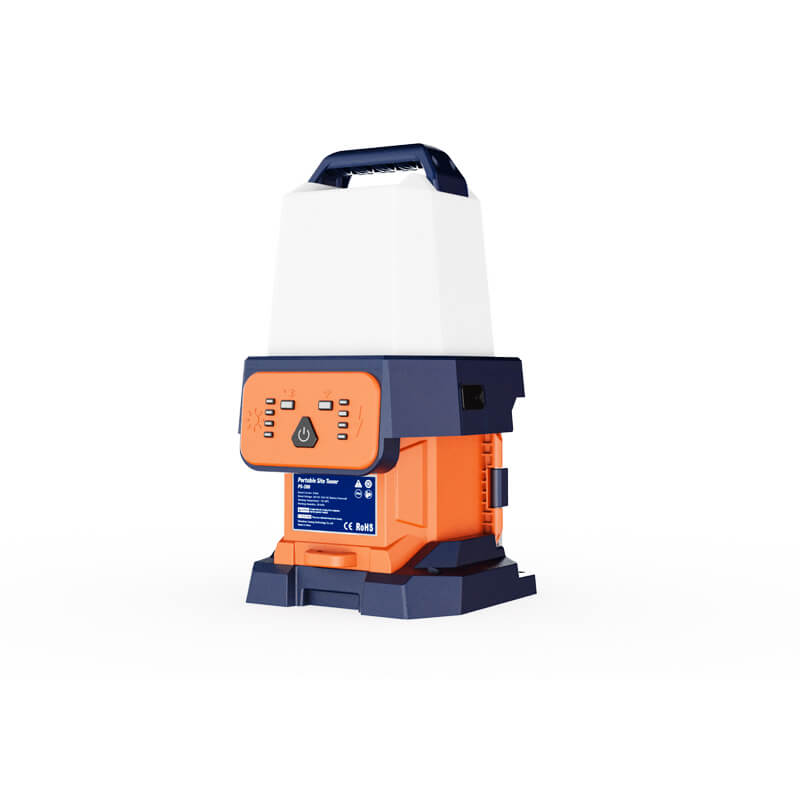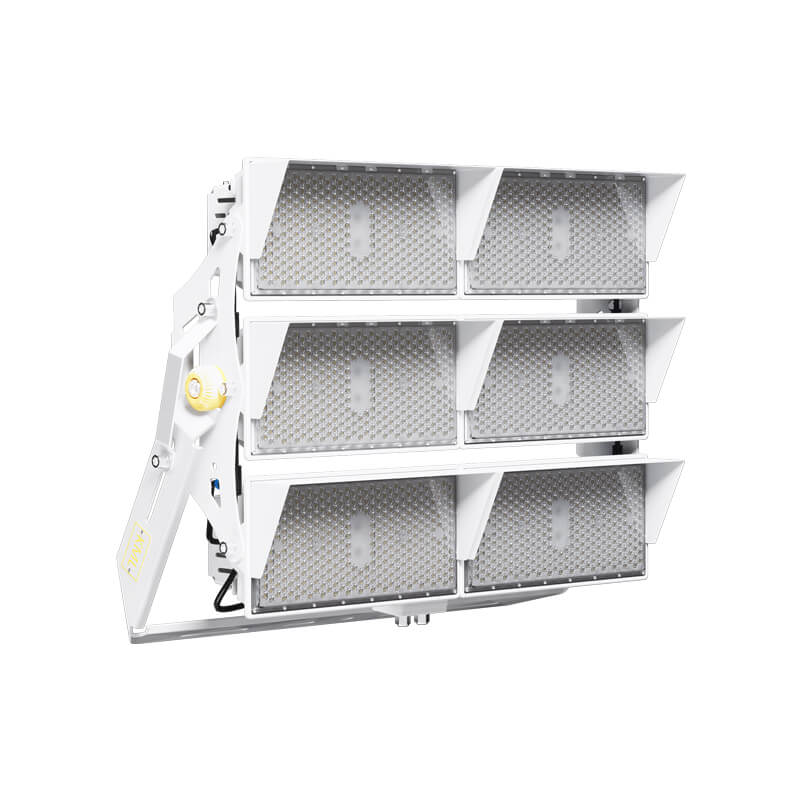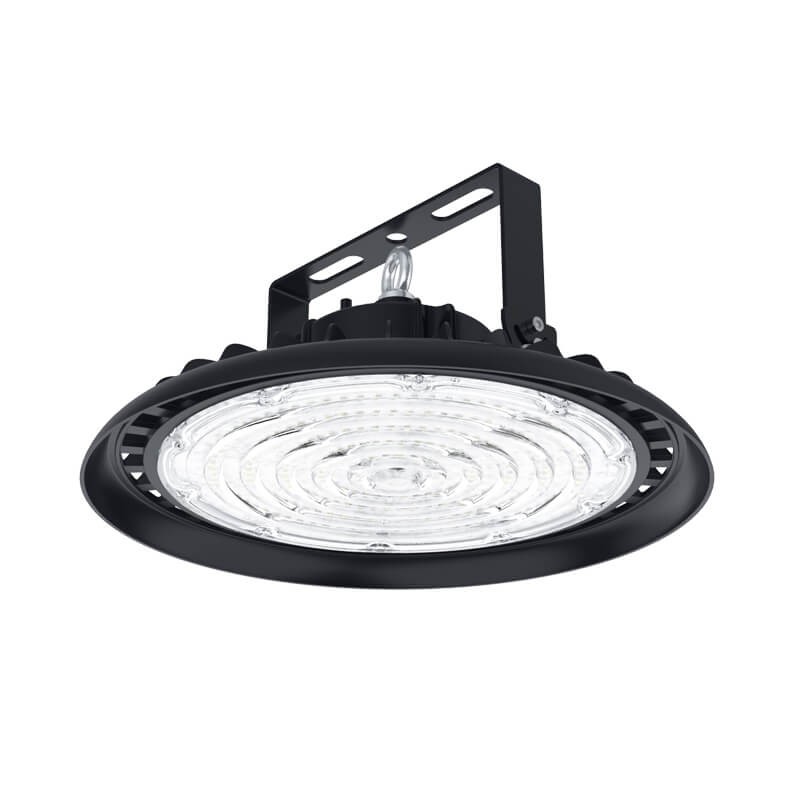Home » Workshop Lighting
Workshop Lighting - Wholesale Custom LED Lights Manufacturer In China
- Murcu offers a wide range of workshop lighting solutions.
- Enjoy high-quality lighting at competitive factory prices.
- Complete customization options to meet your specific needs.
- Fully accepts OEM and ODM workshop lighting requirements.
- Comprehensive services for R&D, manufacturing, and logistics.
- Fast and free quote.
Types of Wholesale Workshop Lighting
Check out Murcu’s wide selection of wholesale workshop lighting, which includes LED high bays and floodlights that can be used in a variety of industrial settings. Our products are built to last and work well, making sure that everyone can see and be safe in any workshop setting. Find the best lighting for your needs right now!
Workshop Lighting Features From Murcu
Murcu’s workshop lighting solutions are built to last, with an impressive luminous efficacy of 200 lm/w, which means they use less energy. Our lights have an SDCM of more than 5, which means that the color quality stays the same, which helps reduce eye strain when working for long periods of time. We offer beam angles of 60°, 90°, and 120° to give you the right amount of light for different workshop layouts. Our products are built to last, and they get a L70/B10 rating after 100,000 hours, which means they will last for years. Our lights are also built to last in tough conditions because they have an IP65 waterproof rating. We offer a five-year warranty on all of our products, so you can be sure you’re making a good investment. Please contact us today for a quote that is just for you!
lm/w Efficacy
SDCM
CRI
Years Warranty
IP Rating
Lifetime
Workshop Lighting Advantages At Murcu
High Efficiency
Our lighting solutions boast a luminous efficacy of 200 lm/w, significantly reducing energy costs.
Long Lifespan
Designed for longevity, our products achieve an L70/B10 rating at 100,000 hours, providing years of reliable service.
Consistent Color Quality
With an SDCM greater than 5, our lights ensure uniform color temperature, reducing visual fatigue for workers.
Versatile Beam Angles
We offer multiple beam angles—60°, 90°, and 120°—to accommodate various workshop layouts and tasks.
Durable Construction
With an IP65 waterproof rating, our lights are built to withstand harsh workshop environments and conditions.
Comprehensive Warranty
We back our products with a five-year warranty, giving you confidence and assurance in your lighting investment.
Ready to make the switch to energy-efficient lighting
Workshop Lighting Customization Options From Murcu
Appearance Design
Choose from a variety of sleek and functional designs to match your workshop's aesthetic and operational needs.
CRI
Select options with a high CRI to ensure accurate color representation, enhancing visibility and detail in your workspace.
Voltage
Our lighting solutions are available in multiple voltage configurations to suit different electrical systems and requirements.
Luminous Efficiency
Customize the luminous efficacy to achieve the ideal balance of brightness and energy efficiency for your specific applications.
Beam Angle
Select from various beam angles—60°, 90°, and 120°—to ensure optimal illumination tailored to your workshop layout.
Dimming or Sensor
Enhance safety and flexibility with options for emergency lighting or dimming capabilities, allowing for adaptable lighting conditions as needed.
Custom Your Workshop Lighting Step By Step
Needs Analysis
Assess your workshop's specific lighting needs, considering factors such as size, layout, and activities performed.
Design Proposal
Define the design requirements, including aesthetics, color rendering, and any special features needed for your workspace.
Sample Review
Request samples of the proposed lighting solutions to evaluate their performance, appearance, and suitability for your workshop.
Production Scheduling
Once the samples are approved, we will schedule production to ensure timely delivery of your customized lighting solutions.
Quality Inspection
Conduct thorough quality checks throughout the production process to ensure that all products meet Murcu's high standards.
Delivery Support
Coordinate the delivery of your customized workshop lighting, ensuring that it arrives on time and in perfect condition for installation.
Your Custom Workshop Lighting Supplier
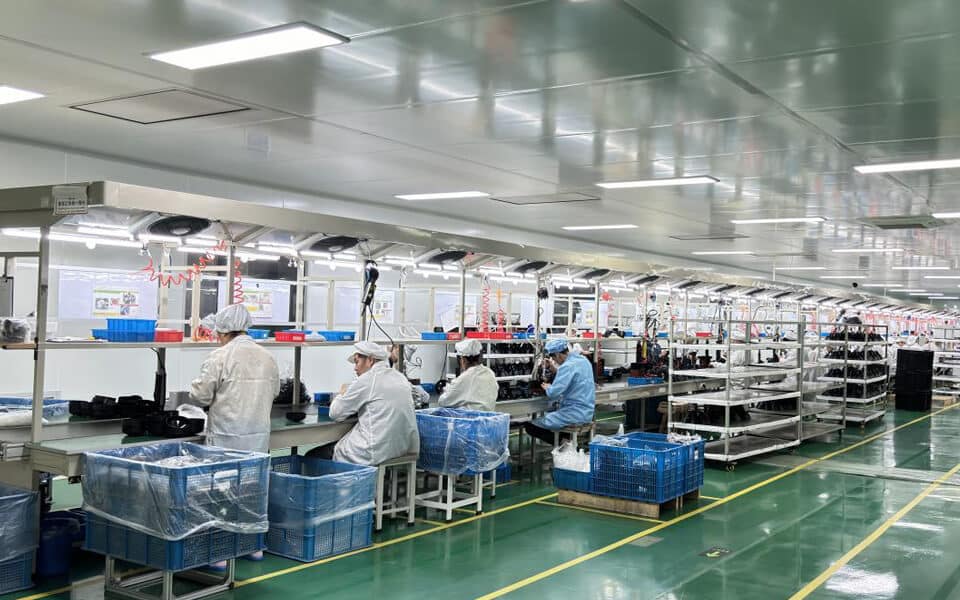
Murcu knows that good lighting is important for both safety and productivity in your workshop. We are dedicated to quality and innovation, which is why we offer custom lighting solutions that are made to fit your needs. Our lights are a smart investment for your business because they not only make things easier to see, but they also save you money on energy costs. They have features like high luminous efficacy, customizable beam angles, and strong durability.
When you work with Murcu, you get our knowledge and full support every step of the way. We make sure your workshop has the best lighting solutions available, from the first consultation to the installation and beyond. Are you ready to change your work space? Contact us today for a personalized quote and let’s illuminate your workshop together!
Your Workshop Lighting Manufacturer Capabilities
At Murcu, we take pride in our full range of manufacturing capabilities, which include designing and researching new lighting solutions in-house to meet your exact needs. With our OEM/ODM services, you can easily customize your product to make sure that your unique vision comes to life. We make it easy for businesses of all sizes to get high-quality workshop lighting by only requiring a minimum order of 1,000 units.
Quality is our top priority, and we have strict quality control systems and efficient order management systems in place. We also offer warehousing and logistics services to make sure your order arrives on time, as well as dedicated customer service after the sale to help you long after you buy. Are you ready to improve the lighting in your workshop? Contact us today to discuss your project and discover how Murcu can meet your lighting needs!
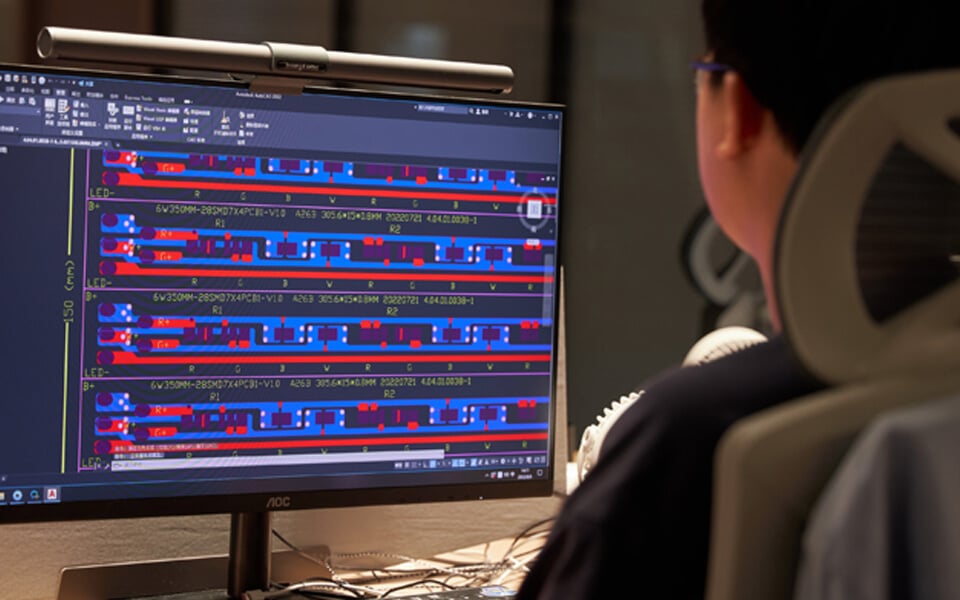
Why Choose Murcu for Workshop Lighting Solutions
10 Years of Experience
With a decade of industry expertise, we understand the unique lighting needs of various workshops.
Diverse Solutions
We offer a wide range of tailored lighting solutions to meet the specific requirements of any workspace.
Quality Assurance
Our products undergo rigorous quality control to ensure reliability and durability in demanding environments.
Innovative Approach
We employ cutting-edge technology and design principles to create efficient and effective lighting options.
Robust Customer Support
Our dedicated support team is always ready to assist you throughout the entire process, from consultation to installation.
Sustainability Focus
Committed to eco-friendly practices, our lighting solutions are designed to reduce energy consumption and environmental impact.
Wholesale Custom Workshop Lighting Manufacturer In China - Murcu
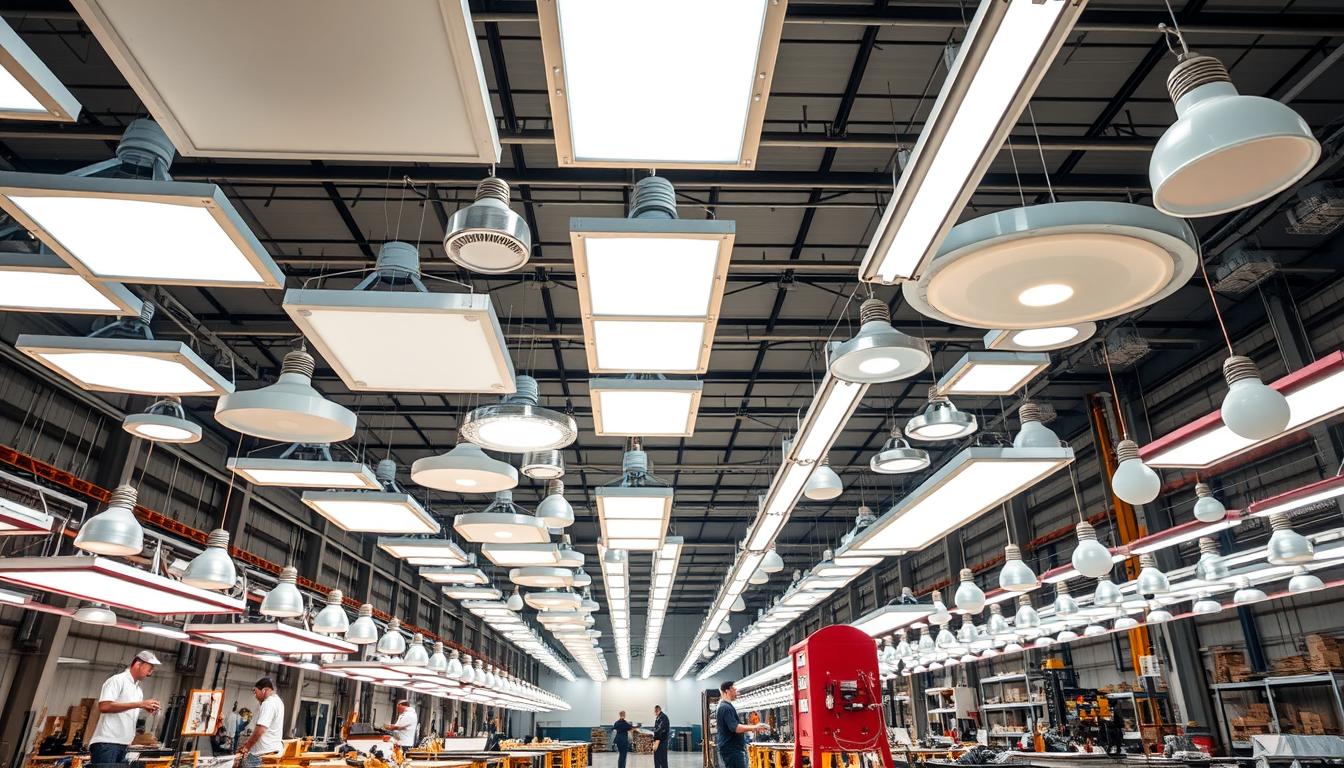
Do you know how much better your work can be if you have the right lighting in your workshop?
We at Murcu know how important good lighting is for safety and work. We’re a top maker in China, ready to give you LED lighting solutions just for you.
We are very good at making custom LED lights in bulk. We improve the safety, efficiency, and quality of your work area.
Key Takeaways
Lighting that is good makes work safer and better.
We make LED lights that are just right for you.
For LED lighting, Murcu has everything you need.
The right lighting makes your work area better.
Murcu sells custom LED lights in bulk.
Introduction to Workshop Lighting
For worker safety and productivity, workshop lighting is very important. It makes it easier to see and lessens eye strain. This is something that every workshop needs.
Goal and Significance
The main purpose of workshop lighting is to make sure that tasks are well-lit. This makes things safer and more productive. Good lighting makes work safer and more efficient by cutting down on glare and shadows.
It also keeps workers happy and less tired. The right lighting is very important in places where accuracy is important.
What is the difference between ambient, task, and accent lighting?
To set up good lighting, you need to know what kinds of lighting there are. Ambient lighting makes the room comfortable by giving it a general light. In a workshop, it’s the main source of light.
Task lighting is focused on the places where people work. It makes certain areas brighter to ease eye strain.
Accent lighting draws attention to certain parts or features. It makes certain machines or workpieces stand out, which makes them look better.
Mixing these lights gives workshops a lighting system that works well. This improves both function and looks.
Key Lighting Concepts & Metrics
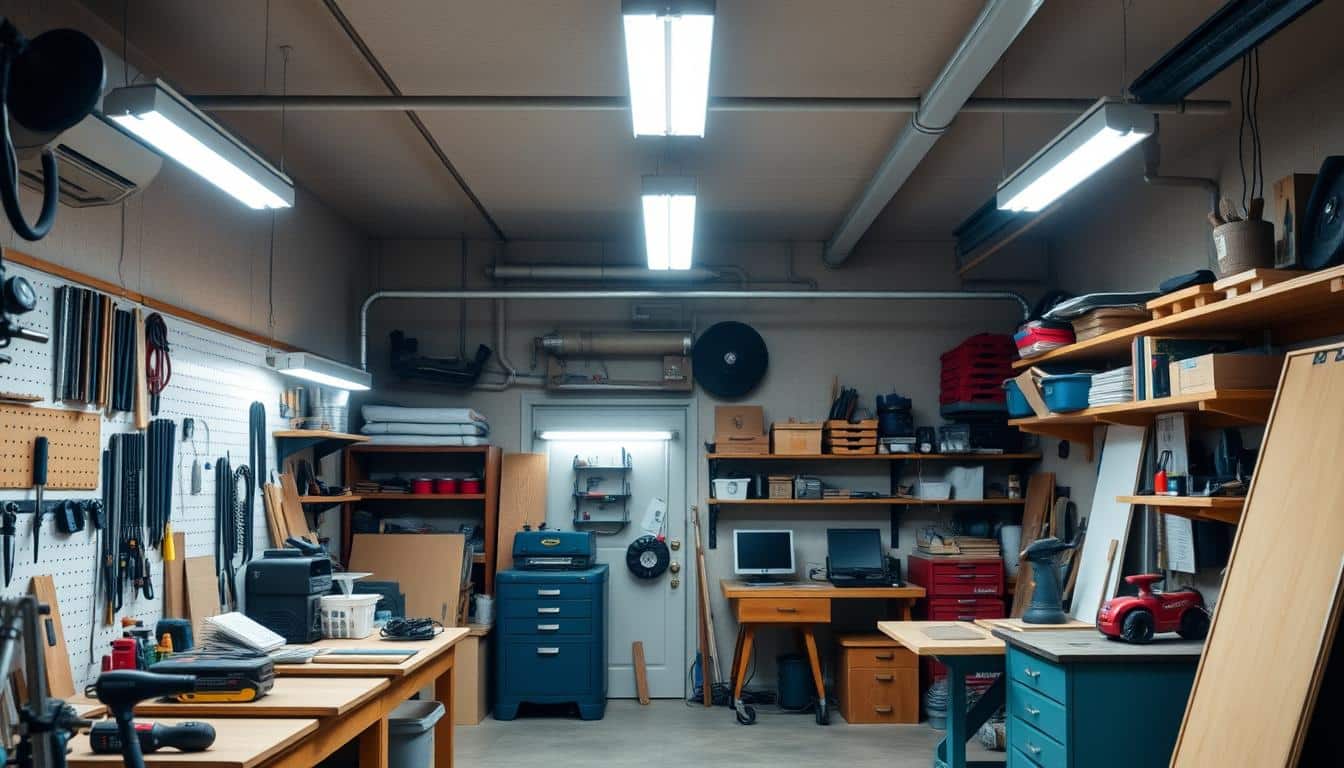
To have a good workshop lighting system, you need to know about lighting concepts and metrics. There are a few important things to think about when choosing lighting for a workshop. This makes sure that the lighting is useful and comfortable for workers.
Lux, Lumen, and Candela
The brightness and intensity of light can be measured in lumens, lux, and candela. Lumens show how much light a source gives off that we can see. Lux measures the amount of light on a surface, taking into account the size of the surface. A candela shows how bright light is in a certain direction.
A living room might have 100 to 200 lux, but a workshop needs 500 lux or more to do detailed work. These numbers help you choose the best lighting for different tasks and places.
Color Temperature (in Kelvin)
The color temperature, measured in Kelvin (K), tells you what color the light is, from warm (yellowish) to cool (bluish). Lower Kelvin values mean that the light is warmer and more yellow. More blue and cool light comes from higher values. The color temperature has a big effect on how a workshop feels and works.
Color Rendering Index (CRI)
The Color Rendering Index (CRI) tells you how well a light source shows colors compared to natural light. A high CRI (close to 100) means true color display, vital in workshops where color accuracy is key.
Consistency, Glare, and Shadows
An even workspace with uniform lighting makes it easier on the eyes. When there is too much light or it is coming from the wrong direction, glare happens and makes you uncomfortable. Shadows can cover up places where people work. For a workshop to be comfortable and productive, you need to find a balance between these.
Types of Light Sources for Workshops
The right lighting is important for seeing clearly and feeling good in workshops. We’ll talk about the different kinds of lights that can be used in workshops. We’ll talk about how to use them and what they can do for you.
LED, fluorescent, and halogen lights
There are many types of workshop lighting, such as LED, fluorescent, and halogen. LED lights are the best choice because they save energy and last a long time. LEDs last longer and use less energy, which saves you money over time.
Fluorescent lights are better than halogen lights, but they have mercury in them, which is bad for the environment. Halogen lights are cheaper to buy, but they use more power and don’t last as long as LEDs.
LED: long-lasting, energy-efficient, and strong
Fluorescent: Uses less energy than halogen and has mercury in it.
Halogen: uses more energy and lasts less time
LED Strip Lights and Shop Lights
LED shop lights make workshops bright and even. They work well in factories, warehouses, and garages. LED strip lights can be used for task, accent, or ambient lighting.
LED shop lights and strip lights both use less energy and last longer. You can dim them to change the amount of light for different tasks.
High Bay and Low Bay Fixtures
High bay lights are great for spaces that are more than 20 feet tall. They spread light all over the place to make sure the area is well-lit. Low bay fixtures work better for tasks that need a lot of focus and are better for rooms with lower ceilings.
You can get LED versions of both high and low bay lights. LEDs use less energy and last longer than old lights.
Vapor-tight & Enclosed Fixtures
Vapor-tight fixtures are made for places where there is dust, moisture, or other contaminants. They are sealed to keep these things out, which makes sure they work well and safely. Many workshops use enclosed fixtures to protect against these things.
These fixtures are perfect for workshops that are hard to work in. They help keep the area where you work safe and healthy.
Design Considerations & Layout Strategies
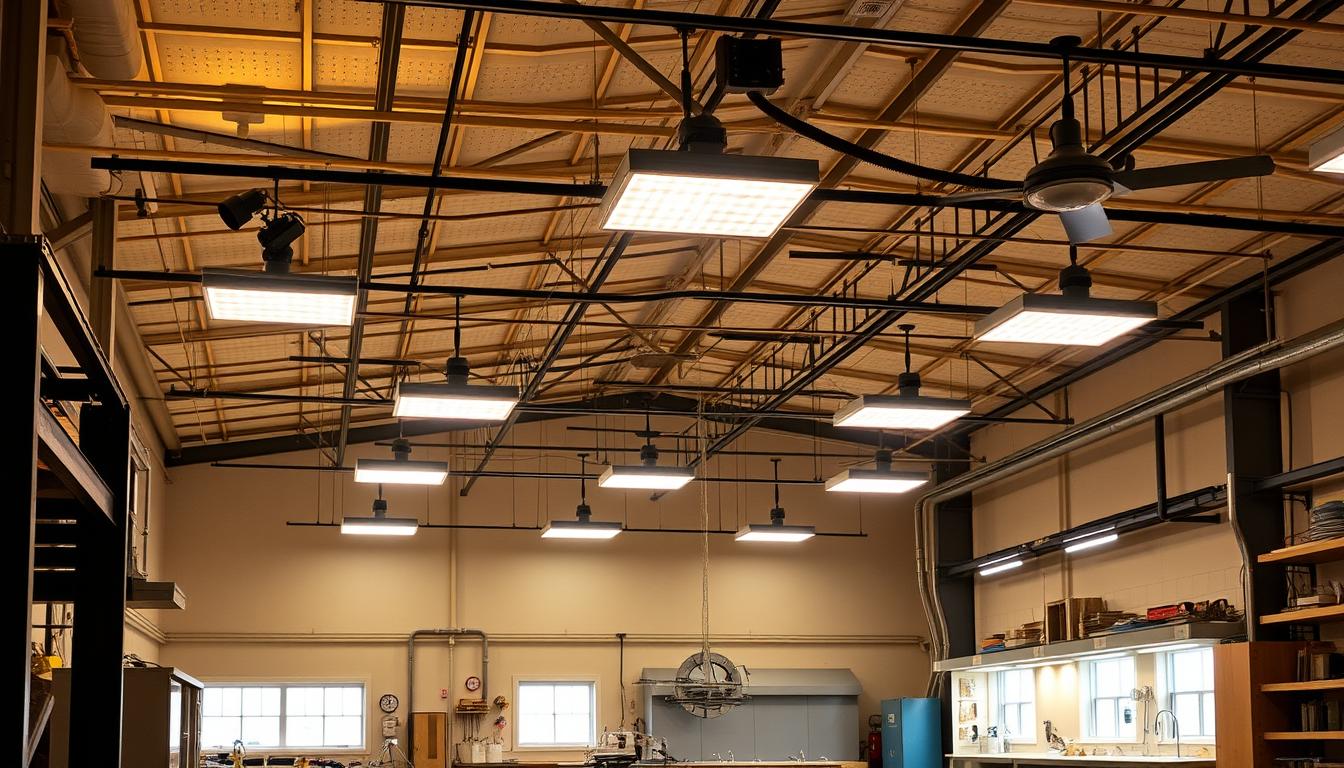
You need to know about workshop lighting design to make your workspace bright and comfortable. You should think about the height of the ceiling, the types of mounts, and the spacing. This helps you get the best light coverage and cuts down on glare.
Types of Mounting and Ceiling Height
The height of your ceiling is very important when choosing lights. High bay lighting is best for ceilings that are high. It lights up big areas well. The type of mounting, such as surface, suspended, or recessed, is also important. It changes how light spreads and should fit the needs of your workshop.
Lights that are mounted on the surface are good for low ceilings.
Lights that are hung from the ceiling help direct light where it is needed.
Recessed lights are a good choice for lighting that is clean and hidden.
Patterns of spacing and coverage
For even light, the lights need to be spaced out correctly. The spacing is based on the light pattern that each fixture makes, which depends on its design and lens. A good rule of thumb is to put them about the same height as the ceiling or a little lower.
Adding light (ambient, task, and accent)
There are three parts to a good lighting system: ambient, task, and accent. Ambient lighting makes the whole area bright. Task lighting is meant to light up work areas. Accent lighting draws attention to certain features or tasks. This layered method creates a lighting setup that is flexible and useful.
The overall level of light is set by ambient lighting.
Task lighting makes it easier to see in the work area.
Accent lighting makes things more interesting and eases eye strain.
Managing Glare and Shadows
Your workshop lighting can be messed up by glare and shadows. Using the right lenses or shields on fixtures can help with glare. Putting fixtures in the right places can also help get rid of harsh shadows. This makes sure that your space is well-lit. To aim light exactly, you might want to use lights with arms that can be moved or tilted.
You can make your workshop better by thinking about these design ideas and planning your lighting layout carefully. A good lighting system also saves energy and needs less upkeep. It’s all about smart workshop management.
Energy Efficiency and Maintenance
When it comes to workshop lighting, it’s important to focus on energy efficiency and maintenance. We examine how these factors influence the performance and longevity of lighting systems.
Taking care of Lifespan and Lumen
People know that LED lights last a long time and stay bright. LEDs stay bright longer than old lights, so you don’t have to replace them as often. Lumen maintenance is how well a light stays as bright as it was when it was first turned on. L70 rates LEDs by how long they stay at 70% brightness.
For instance, high-quality LEDs can keep 70% of their brightness for 50,000 hours. This makes them perfect for workshops where good lighting is important.
Power Use and Efficiency
Lighting in a workshop needs to be energy-efficient. LEDs use much less energy than old lights like fluorescent and halogen. Switching to LEDs can cut down energy use and costs.
| Lighting Type | Energy Consumption (Watts) | Lifespan (Hours) |
|---|---|---|
| LED | 9–12 | 50,000+ |
| Fluorescent | 15–40 | 8,000–10,000 |
| Halogen | 20–50 | 2,000–4,000 |
Cleaning and Maintenance
It’s important to take care of your lighting. Dust can make light less bright. To keep your lights working well, you should clean them often.
“Cleaning and maintaining lighting fixtures on a regular basis not only makes them work better, but it also makes the workplace safer.” – Expert in Lighting
Full Replacement vs. Retrofit
A lot of the time, workshops have to choose between getting new lights or fixing up old ones. Retrofitting is the process of replacing old lights with new ones that use new technology, such as LEDs. Getting all new lights made to save energy is what full replacement means.
Retrofitting can save money, but new lights might use less energy and need less maintenance. Think about your workshop’s needs to pick the best option.
Safety, Codes & Environmental Factors
The lighting in a workshop must meet strict safety and environmental rules. For a safe place to work, it’s important to pick lighting that meets these needs.
Ratings for safety (IP and Wet/Damp)
IP (Ingress Protection) ratings and safety ratings tell you if lighting will work in different workshop settings. IP ratings show us how well a light can deal with water and dust. For instance, an IP67 light can handle water up to 1 meter deep and is dustproof.
These ratings can help you choose the best lights for your workshop.
Electrical & Wiring Considerations
To avoid shocks or fires, it is very important to be safe with electricity and wiring. This means using the right wiring and circuit breakers, making sure all the connections are tight, and following local codes. We also need to make sure that the lights’ voltage and frequency are right for our electrical system.
Rules and Standards for Workspaces
There are a lot of rules and guidelines for lighting in the workplace, from OSHA to local laws. These rules set the lowest levels of light, glare, and safety. We stay safe and out of trouble with the law by following these rules.
The effects of the environment (dust, humidity, temperature)
The performance and lifespan of lights are impacted by dust, humidity, and temperature. For example, rust can happen when there is too much humidity, and dust can make light quality worse. Choosing lights that can handle the conditions in your workshop makes sure they work well and last longer.
We can safely and effectively light our workshop by taking into account safety ratings, electrical needs, standards, and the environment. This careful approach boosts productivity and safety in our workspace.
Example Layouts of Workshop Lighting
We use case studies and layouts to show how to light workshops well. We talk about workshops of all sizes and types.
Small Garage or Workshop
Small garages or workshops need good lighting. A good plan for lighting can make the room look better. For instance, LED shop lights and strip lights can be used to evenly light a 20′ x 20′ garage.
| Area | Lighting Type | Lumens |
|---|---|---|
| Workbench | LED Strip Light | 4,000 |
| General Area | LED Shop Light | 8,000 |
Medium-Sized Industrial Workshop
Medium-sized industrial workshops need lights because they have more space and higher ceilings. These areas work best with high bay fixtures.
A study on a 50′ x 100′ workshop found that high bay LED lights worked well. They were 20 feet apart and lit up the area to 50 lux. This is good for jobs that need a lot of detail.
Layouts for Workshops with Multiple Uses
Workshops that do a lot of different things, like working with wood and metal, need lights that can be moved around. It’s important to use different kinds of light.
For instance, a workshop might use high bay lights to light up the whole space, task lights to light up specific areas, and accent lights to light up certain machines or pieces.
Important Things to Think About:
Think about what you did in the workshop.
Check the height of the ceiling and how to hang lights.
Use different types of lights to make the room look nice and work well.
Installation Tips & Best Practices
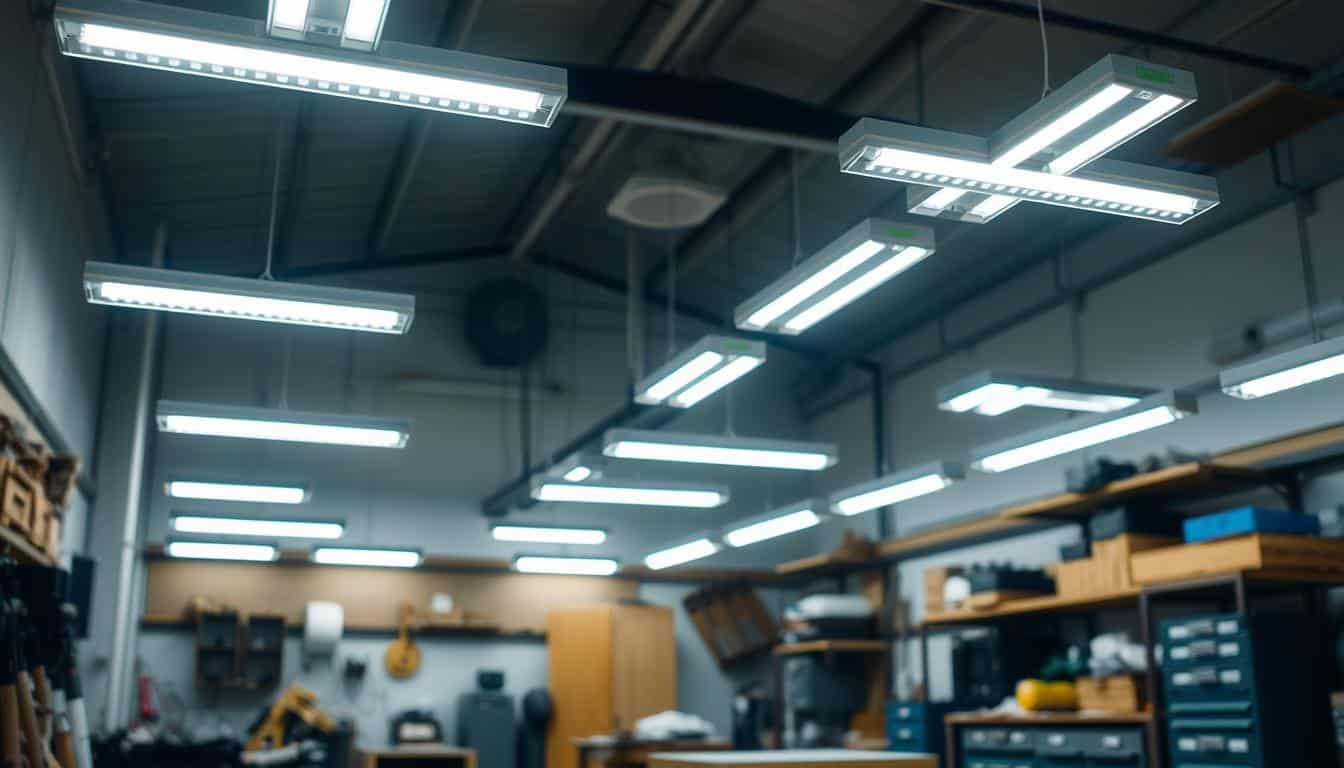
It’s a big deal to set up the lights in the workshop. It needs to be planned and done carefully. A good lighting system makes your workshop safer and helps you get more done.
Installing wiring and fixtures
Getting the wiring and mounting right is very important. To avoid problems, always follow the maker’s instructions. To stay safe, don’t forget to turn off the power first.
When you put up lights, think about your ceiling or wall. For a strong installation, use the right fasteners. Anchors for drywall or screws for masonry are both good options.
Linking or daisy-chaining fixtures
Linking fixtures can help you save money and make wiring easier. But make sure you don’t overload by checking how many you can connect. The maker’s guide has it.
Use the right wire gauge to connect things so that power flows well. This makes sure that all the lights get enough power.
Testing and Balancing the Levels of Light
You have to test your lights after you set them up. Check the light with a light meter. This helps you find any spots that are too dark or too bright.
You may need to change the positions or angles of the lights. Think about the light’s color and how it makes things look. This affects how well you can do your work.
| Task Area | Recommended Lux Level | Color Temperature (K) |
|---|---|---|
| General Workshop | 200–500 | 4000–5000 |
| Detailed Workbench | 500–1000 | 5000–6500 |
Future Scalability
When you set up lights, think about what you will need in the future. Adding more is easy with a modular system. This will save you time and money in the long run.
Following these tips will make the lighting in your workshop great. It will be safe, efficient, and ready for the future.
Troubleshooting & Common Challenges
It’s important to fix workshop lighting problems like overheating and broken fixtures. Good lighting makes people work better and keeps them safe. But a lot of things can go wrong that affect how well the lights work.
Dark spots and uneven lighting
Lighting that isn’t even makes your eyes tired and lowers your productivity. Make sure the lights are bright enough for the area and spread out well. Regular maintenance, like cleaning and lamp changes, keeps the light even.
Flicker, noise, or humming
Lights that flicker, make noise, or hum can be annoying and are a sign of bigger problems. These often come from bad dimming controls or low-quality lights. Picking high-quality LED lights and the right dimming systems will fix these problems.
“The quality of the light can have a big impact on how comfortable and productive workers are.” “Making sure that lighting systems are set up and cared for correctly is very important.” — Expert in Lighting
Problems with heat and overheating
Overheating shortens the life of lights and is a safety hazard. Keep lights in cool places and pick ones that work with the temperature of your room. If you install things right and check them, you can catch heat problems early.
Fixtures or controls that don’t work together
Flicker, lower efficiency, and safety risks can all be caused by bad fixtures or controls. Choose lights and controls that work well in your workshop. It helps to talk to a lighting expert to make the right choices.
We keep our workshops bright, safe, and productive by fixing these common problems in smart ways.
Final Thoughts
A good workshop lighting system is important for better work, safety, and comfort. We talked about how to choose the right lights. This means looking at things like the kinds of light, how much energy they use, and the rules for safety.
Follow these steps to get the best lighting for your workshop. These include controlling glare and shadows, layering light, and making sure the light is even. It’s also helpful to know the rules and design guides.
Look at resources from reliable suppliers and industry groups for more information. They give you great advice and tips on how to set up good lighting in your workshop. Murcu and other companies have a lot of different products and skills.
You can make a lighting system that improves work, safety, and comfort by following the advice in this article and using these tools.
Workshop Lighting FAQs
What are the advantages of using LED lights in the workshop?
LED lights for workshops use less energy and last a long time. It also makes your work area safer. LEDs save you money and help the environment because they use less energy than old lights.
How do I pick the right color temperature for the lights in my workshop?
The color temperature you choose depends on what you need to do. Cool colors (5000K–6500K) are best for detailed work. For general lighting and mood, warmer colors (3000K–4000K) are better.
What sets lumens apart from lux?
Lumens tell you how much light a source gives off. Lux shows how much light a surface gets. To put it another way, lumens measure how much light comes out of something, and lux measures how much light there is at a certain point.
How do I find the right amount of space between the lights in my workshop?
The type of lighting, the height of the ceiling, and the tasks you need to do all affect spacing. For even lighting, a good rule is to space lights 1 to 2 times the height of the ceiling.
What are the benefits of using LED strip lights in a workshop?
LED strip lights are easy to put up, save energy, and can be bent. They work well for task, accent, and ambient lighting in workshops.
How can I make sure that the lights in my workshop are safe and follow the rules?
Check safety ratings, electrical needs, and follow the rules to make sure your lighting is safe and up to code. This makes sure that your lighting is up to code.
What are the advantages of upgrading old lighting with LED lights?
Adding LEDs to old lights saves energy, makes the light better, and lowers the cost of upkeep. It’s a good idea to improve the lighting in your workshop.
What should I do if the lighting in my workshop is uneven?
Check the spacing, levels, and things that are in the way to fix uneven lighting. You can even out the light by changing the lights, adding more, or taking away blocks.
What are the most important things to think about when making a lighting system for a workshop?
When you design, think about the tasks you need to do, the height of the ceiling, how to mount the light, and how to layer it. This makes the workspace bright and cozy.
How can I make my workshop lighting use less energy?
Use LEDs, turn off lights in areas that aren’t being used, and use controls like sensors or timers to save energy. This cuts down on waste.
